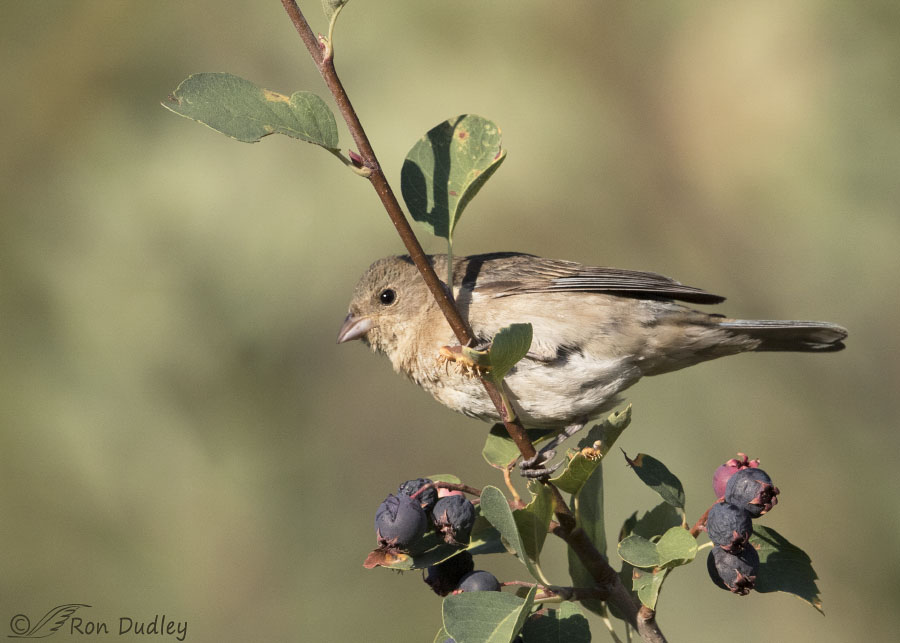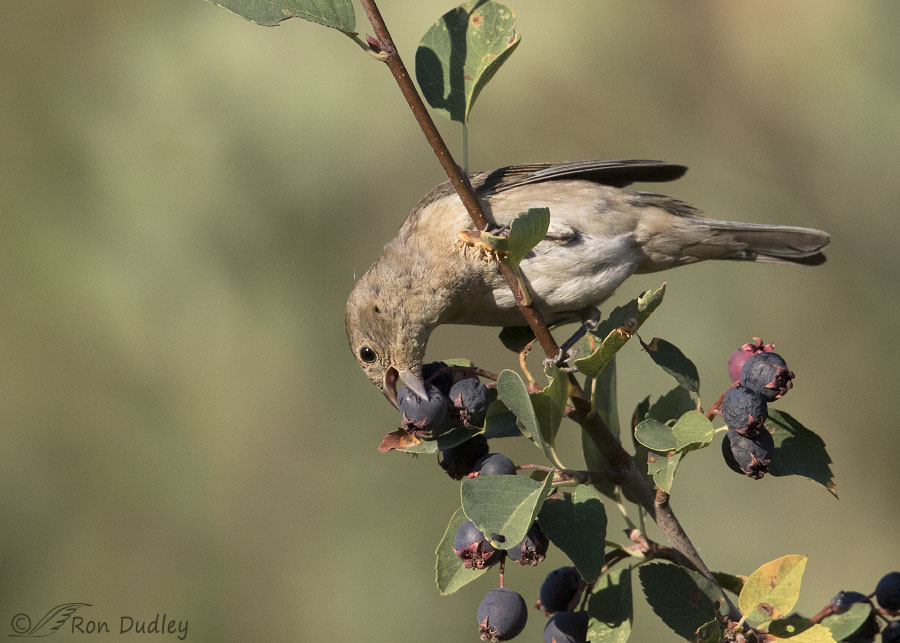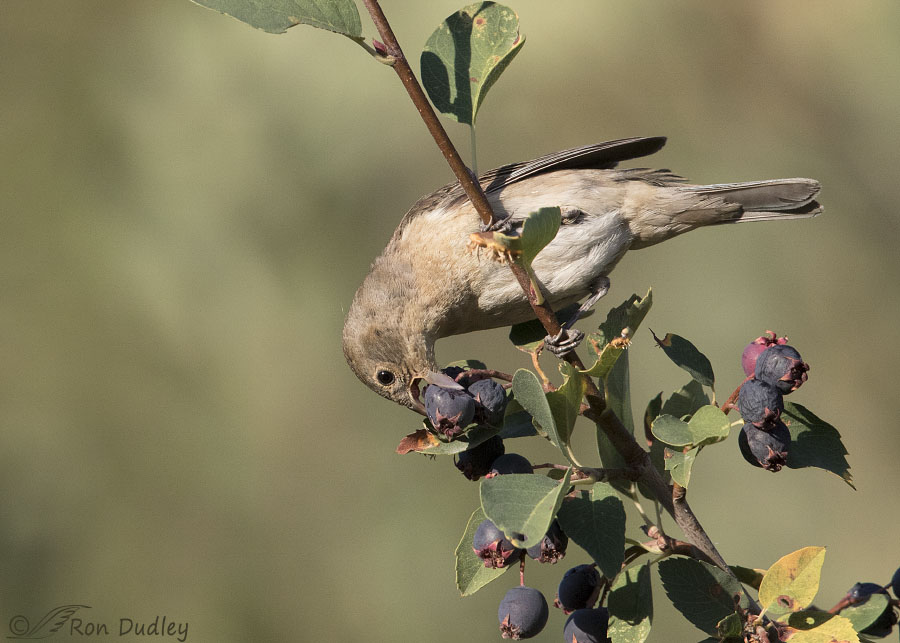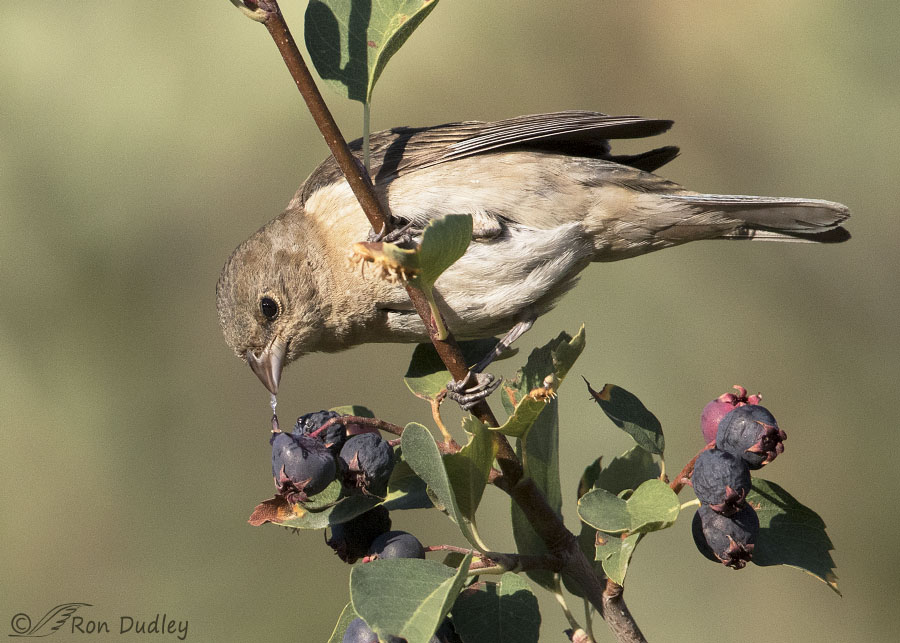It’s often little things like the subtle survival skills of birds that interest me most.

1/3200, f/6.3, ISO 800, Canon 7D Mark II, Canon EF 500mm f/4L IS II USM + EF 1.4 III Extender, not baited, set up or called in
Yesterday morning I photographed this hungry female Lazuli Bunting in the Wasatch Mountains and serviceberries were on her breakfast menu, especially that prime berry at front left.
But as I see it there are two problems with a bunting trying to eat serviceberries. They’re too big to swallow whole and they’re hanging from flexible stems so if the bird tries to peck into them with its beak to get at the soft juicy parts they just rebound away and aren’t punctured. That skin is relatively tough and not easy for them to get through.
But this bird had a strategy.

1/3200, f/6.3, ISO 800, Canon 7D Mark II, Canon EF 500mm f/4L IS II USM + EF 1.4 III Extender, not baited, set up or called in
Several times she opened her beak about as wide as she could which engulfed a large part of the berry in her beak and then she chomped down to flatten it and partially break open the skin.

1/3200, f/6.3, ISO 800, Canon 7D Mark II, Canon EF 500mm f/4L IS II USM + EF 1.4 III Extender, not baited, set up or called in
And then after seventeen more clicks of my shutter she did it again but this time the berry was already slightly flattened so she was able to really wrap her beak around it before she applied any pressure. She made no attempt to pluck it off its stalk that I noticed and I was watching her carefully.

1/4000, f/6.3, ISO 800, Canon 7D Mark II, Canon EF 500mm f/4L IS II USM + EF 1.4 III Extender, not baited, set up or called in
And then she simply dipped her beak into the now partially open berry and leisurely helped herself to its soft, juicy pulp. (I’ve cropped tightly on the bird for this shot for better detail).
Like I said it’s a little thing but very often it’s the little things that enable birds to survive. When we’re watching birds in the field we rarely notice subtle behaviors like this because they typically happen too fast and we’re usually not close enough to the action to see the required detail.
But the magic of telephoto photography can allow us to see and appreciate them. I think that’s neat as hell.
Ron
PS – Did any regular readers notice anything that looked familiar on the serviceberry plant?
I see two yellow-orange structures growing off the plant that strongly resemble the mold/rust I featured on a Gray Catbird post eleven days ago. That catbird was also perched in a serviceberry bush. I’ve seen several other examples of this presumed mold growing on serviceberry since then so I suspect it’s much more common than I thought.
Addendum: Early this afternoon I received the following email from fellow photographer Ed King. Apparently Ed knows a lot more about these fungi than the rest of us. Thank you, Ed – mystery solved as far as I’m concerned:
“Ron,
Noticed another reference to the fungus on Serviceberry in your blog post today.
The fungus you’re seeing on Serviceberry leaves is likely Cedar-apple rust (or a close relative). The structures that caught your eye are aecia — reproductive structures formed on the underside of the leaf — that produce aeciospores, and the horn-like projections are tubes through which the aeciospores are released. As you probably recall, from biology text illustrations of Stem Rust of Wheat, perhaps, rust fungi can have complex lifecycles that may involve the production of as many as five different spore types, and typically require alternating infection of two different host plants (though different rust species can vary in these characteristics).
In the case of Cedar-apple rust, completion of the life cycle depends on alternating infection of juniper and apple trees, though Serviceberry can serve as a substitute for apple.
Hope this helps to clear up the Serviceberry/fungus mystery.
Ed King”


I much prefer the pulp of serviceberries rather than the skin, but I’m much too big and clumsy (and lack a beak) to make a nice lunch of it.
I’d probably prefer the pulp too, Lyle. But I have a Facebook friend who eats lots of the entire berries whenever possible.
Ron, you captured the actions of a very innovative and hungry bird. We have trees in our back yard that shed berries that look somewhat like those you’ve shown on your post. However, I have not observed birds eating those on the ground. Perhaps the berries on the bush/tree are more appetizing.
Thank you for an interesting post, Ron
Thanks, Alice. I guess when you’re hungry innovation comes more easily…
Hooray for the persistence and downright cleverness of ‘birdbrains’. And for your knowledgeable commentators. And for your incredible persistence (and skill).
Definitely a Three Cheers morning (at least).
That email from Ed sure cleared up a mystery in my mind, EC. One or two others got it pretty close too. Smart readers I have…
This tree has the “sputnik” fruiting bodies discussed earlier. I thought it was a fungus I hadn’t seen on the serviceberry in front of my house.
Thanks so much for posting these rapid fire behavior shots. It helps me understand what I’m observing through binoculars much better.
Thanks, Pam. Just to be clear a rust is a type of fungus.
Very nice photos Ron. Would have been more colorful if it had been the male, but she is beautiful in her own way. Like the Marines say, “Improvise”, and birds and wildlife are sure good at that. Hope you are feeling well.
Everett Sanborn
Prescott AZ
Everett, actually this time of year the females tend to be more attractive because the colorful males in molt look particularly scruffy.
I love learning things like this. Thank you. Birdbrain is a misnomer when you take things like this into account.
It sure is. Thanks, Arwen.
I love your behavioral series, always.
Thank you, Sallie.
Clever girl! 😃 I wonder, as the berries get more and more past their prime, if the birds ever get a little tipsy from the fermenting fruit. 🍻
The level of sexual dimorphism in this species just gets me every time — to me, the females don’t resemble the males at all.
Marty, more than “get a little tipsy”, birds eating fermented sometimes get flat-out drunk. Waxwings are well known for it.
Wonderful series. It is fascinating to see the way birds learn to cope with their environment, and this bird is clearly a good learner. For me, one of the biggest rewards of being out in nature is seeing the behaviors of the various critters. (I’m not sure I can see the fungus in these shots, though I do easily see the rust that Kathy mentions.)
Susan, imagine how many of these subtle behaviors humans are unaware of. It boggles my mind…
Great series Ron! I have serviceberry which I planted with hopes of attracting birds but so fat, no luck.😭
Charlotte
Thank you, Charlotte, I wish you better luck with your serviceberries and birds in the future.
Very interesting post, my guess from watching birds is that some birds condition their fruit before eating it, while others take the whole berry dependent on the size of their bill, throat and experience.
Wildlife has to learn quickly how to survive if they are going to survive. If humans had to live under the same conditions wildlife has to go through, I think we would see some very smart folk, and I also think our population would diminish markedly.
I agree with your observations about humans, Dick. Thanks.
Now don’t you wonder how long it took her to learn that skill? My guess…not very long. Creatures always amaze me with their abilities. I read an interesting article last week asking the question are animals smarter than us? Many times I believe so…we could learn a lot about life, living, and humanity from them. 😍 I love to sit and observe what goes on with nature around me. Spent three hours yesterday with two Belted Kingfishers…a first time ever for me.
I did notice the rust spots on the leaves and affected fruit…caught my eye right away. There has to be junipers and hawthorns in the area…the spores can travels on the winds a great distance to infect susceptible plants. Serviceberry and hawthorns are in the same plant family, the Rose family so susceptible to similar problems. My humble thought on the matter… ☺️
“There has to be junipers and hawthorns in the area”
There certainly are, Kathy – both of them. Not too many junipers but lots of hawthorns. Thanks for that insight.
How interesting! 🙂 The adaptations birds/animals have are endless and fascinating…. I’m guessing they can also tell how ripe the berry is with that process……
I think they can, Judy. At first this bird was sampling a berry behind this one but it quickly abandoned it to spend more time on the “prime” berry.